2. 中国冶金地质总局矿产资源研究院, 北京 101300;
3. 中国科学院地球科学研究院, 北京 100029;
4. 中国科学院大学地球与行星科学学院, 北京 100049;
5. 中国地质大学资源学院, 武汉 430074;
6. 河南省卢氏县国土资源局, 三门峡 472200
2. Institute of Mineral Resources Research, China Metallurgical Geology Bureau, Beijing 101300, China;
3. Institutions of Earth Science, Chinese Academy of Sciences, Beijing 100029, China;
4. College of Earth and Planetary Sciences, University of Chinese Academy of Sciences, Beijing 100049, China;
5. Faculty of Earth Resources, China University of Geosciences, Wuhan 430074, China;
6. Bureau of Natural Resources of Lushi County, Sanmenxia 472200, China
稀有金属包括锂、铍、铌、钽、铯、锆、铪和铷,主要应用于国防、航空、航天等工业领域,是重要的战略金属。花岗伟晶岩是稀有金属主要的赋存岩石。绿柱石(Be3Al2Si6O18)是花岗伟晶岩中最常见也是最重要的铍矿石矿物,其产出较为广泛,包括文象伟晶岩带、细粒钠长石带、块体微斜长石带、石英-白云母带、锂辉石-钠长石带和晶洞巢体等(Černý et al., 2003; Zhou et al., 2015, 2018; Michallik et al., 2017)。纯的绿柱石是无色的,由于Cr3+、V5+、Fe2+、Fe3+、Mn2+、Rb+、Cs+等金属离子的替代,绿柱石可呈现多种颜色,包括黄绿色、绿色、蓝色、灰白色和浅玫瑰色等(Hawthorne and Černý, 1977; Viana et al., 2002, Mihalynuk and Lett, 2003; Groat et al., 2010; Fridrichová et al., 2015; Lum et al., 2016)。绿柱石晶体多为长柱状,亦见板柱状,由于Cs和Li等元素进入晶格,使得绿柱石由六方晶体向斜方晶体转变(Hawthorne et al., 2004)。绿柱石的化学组成和内部分带特征可指示伟晶岩的分异程度,并示踪伟晶岩岩浆演化过程(Grundmann and Morteani, 2008; Wang et al., 2009; Uher et al., 2010; Merino et al., 2013)。
东秦岭地区之北秦岭带产出数以千条花岗伟晶岩脉,其中以河南三门峡卢氏官坡地区最为密集,是我国重要的花岗伟晶岩区,也是重要的稀有金属成矿区(卢欣祥等, 2010)和铀矿成矿远景区(冯明月等, 1997)。东秦岭花岗伟晶岩的矿化稀有金属元素包括Nb、Ta、Be、Rb、Li、Cs、Th等(栾世伟, 1979, 1985)。前人针对东秦岭花岗伟晶岩开展了矿物学(刘永先, 1984; 张志兰, 1983, 1984; 何瑞林和曹恩魁, 1985; 白峰等, 2011)、地球化学特征(栾世伟, 1979)和成矿规律(陈西京, 1982; 王令全等, 2011; 何玉良和黄岑杨, 2012)研究。本文旨在查明卢氏地区南阳山矿区、七里沟-前台矿区、蔡家沟矿区和瓦窑沟矿区中的锂矿化伟晶岩和铍矿化伟晶岩的内部结构分带和伟晶岩类型。在此基础上,以绿柱石为主要研究对象,通过绿柱石的化学组成与内部分带特征分析,查明不同矿化类型伟晶岩中绿柱石的元素替代机制,厘定不同矿化类型伟晶岩的分异演化程度序列,揭示伟晶岩分异演化程度的绿柱石潜在指示标志,探讨东秦岭官坡锂矿化伟晶岩的稀有金属成矿过程和成矿机制。
1 区域地质概况秦岭造山带是我国中央造山带的重要组成部分。东秦岭伟晶岩区位于秦岭造山带东段的北秦岭加里东期造山带,是由商州-丹凤断裂和朱阳关-夏馆断裂夹持的北秦岭单元分布区(图 1)(Ratschbacher et al., 2003; 卢欣祥等, 2010),该地区从新元古代至中生代经历了多期构造运动和多次板块俯冲碰撞作用(王晓霞等,2015; 秦克章等, 2017)。北秦岭单元的岩性组合为前寒武纪含石榴子石黑云斜长片麻岩、石榴硅线片麻岩、角闪岩和大理岩(Meng and Zhang, 2000; 时毓等,2009)。北秦岭单元北侧边部出露高温片麻岩相和超高压榴辉岩相变质岩石(张建新等, 2011; Wu and Zheng, 2013; Wang et al., 2014),在490~480Ma经历了超高压变质作用和角闪岩相退变质作用(Cheng et al., 2011, 2012; Wu and Zheng, 2013)。北秦岭单元内产出新元古代花岗岩(Chen et al., 2006)、早古生代镁铁质侵入岩(Wang et al., 2014; Zhang et al., 2015)以及志留纪-泥盆纪花岗岩。其中,志留纪-泥盆纪花岗岩(包括漂池、灰池子、桃坪、骡子坪和黄柏岔等)分布广泛(张宏飞等,1996; 卢欣祥,2000; 王涛等,2009; 雷敏,2010; Qin et al., 2014, 2015; 王晓霞等,2015),与花岗伟晶岩的关系最为密切(卢欣祥等,2010)。

|
图 1 东秦岭伟晶岩区区域地质简图(据卢欣祥等,2010;张成立等,2013;Qin et al., 2014, 2015改绘) A-峦庄伟晶岩密集区; B-官坡伟晶岩密集区; C-龙泉坪伟晶岩密集区; D-商南伟晶岩密集区 Fig. 1 Geological sketch map of the East Qinling pegmatite district (modified after Lu et al., 2010; Zhang et al., 2013; Qin et al., 2014, 2015) A-Luanzhuang pegmatite-concentrated area; B-Guanpo pegmatite-concentrated area; C-Longquanping pegmatite-concentrated area; D-Shangnan pegmatite-concentrated area |
东秦岭伟晶岩区产出数以千条花岗伟晶岩脉,由西北至东南可划分4个伟晶岩密集区(峦庄、官坡、龙泉坪和商南)(图 1)(卢欣祥等,2010)。伟晶岩主要呈脉状或囊状分布于大理岩、透辉大理岩、片麻岩、角闪片岩、辉长岩中,少数侵入于基性岩中。根据长石和云母的分类方案(栾世伟,1985),东秦岭花岗伟晶岩可划分为7个伟晶岩类型,包括黑云母-微斜长石型、二云母-微斜长石型、白云母-微斜长石型、白云母-微斜长石-钠长石型、白云母-钠长石型、锂云母-微斜长石-钠长石型和锂云母-钠长石型(卢欣祥等,2010);根据稀有金属矿化组合,其可划分为Nb-TR型、Be-白云母型、Li-Be型、Be-Nb型和Cs-Ta型(栾世伟,1985)。矿石矿物包括白云母、黑云母、钾长石、锂云母、锂辉石、锂电气石、绿柱石、铌铁矿、钽铁矿、钽锰矿、铯榴石、细晶石、黑稀金矿等。普遍认为东秦岭花岗伟晶岩是加里东期花岗质岩浆活动的产物(卢欣祥等,2010)。本次研究集中于稀有金属伟晶岩,其中,锂矿化伟晶岩主要产出于官坡密集区的南阳山、七里沟-前台和蔡家沟矿区,铍矿化伟晶岩产出于龙泉坪密集区的瓦窑沟矿区(图 1)。
2 花岗伟晶岩内部结构分带特征和类型东秦岭卢氏花岗伟晶岩区由西北向东南依次发育南阳山、七里沟-前台、蔡家沟和瓦窑沟伟晶岩型稀有金属矿区。
2.1 南阳山矿区南阳山锂矿区产出伟晶岩脉40余条。伟晶岩走向呈近南北向、北西-南东和近东西向,形态以脉状和透镜状为主。矿区地层为下元古界秦岭群陶湾组的透辉石大理岩、透辉石岩、白云石大理岩和斜长角闪片岩。本次研究集中于703号脉和302号脉。南阳山703号脉矿石矿物为锂辉石、锂电气石、锂云母、铯榴石和铌铁矿族矿物。内部结构分带:边部带石英-绿色电气石、外部带石英-白云母-电气石-铌铁矿族矿物-少量绿柱石、中间带白色锂辉石-灰色石英-铌铁矿族矿物以及块体微斜长石和块体石英-铯榴石核。703号脉露头顶部产出交代单元,即细粒钠长石-石英-绿色电气石和条带状锂云母-锂电气石-灰色石英-钠长石-少量磷锂铝石。南阳山302号脉分带不明显,伟晶岩脉以微斜长石-钠长石-白云母-铌铁矿族矿物-电气石为主,发育铍-铌-钽矿化。
2.2 七里沟-前台矿区七里沟-前台矿区发育20余条伟晶岩脉。伟晶岩走向近东西向、北东-南西向和北西-南东向,呈脉状和透镜状。矿区地层是下元古界秦岭群陶湾组黑云母阳起片岩夹角闪片岩、白云大理岩和石英片岩。前台伟晶岩脉主体为锂辉石-灰色石英-钠长石-微斜长石和锂云母-石英,边部带产出细粒钠长石-石英-铌铁矿族矿物。
2.3 蔡家沟矿区蔡家沟矿区发育有30余条伟晶岩脉。伟晶岩走向呈近东西向和北东-南西向,形态以脉状和透镜状为主。矿区地层为下元古界陶湾组云英片岩、斜长角闪片岩夹黑云方解石片岩。本次研究对象为大西沟和韭菜沟伟晶岩脉。大西沟伟晶岩脉矿石矿物主要为磷锂锰矿和锂辉石。内部结构分带:由上向下,分布条带状石英-钠长石-磷锂锰矿-绿色电气石、白色锂辉石-灰色石英-铌铁矿族矿物-白云母-钠长石或粗粒绿色锂辉石-块体微斜长石-少量石英和钠长石、粗粒钠长石-石英。韭菜沟伟晶岩脉矿石矿物主要为磷锂铝石、磷锂锰矿和锂辉石。矿石堆见白色锂辉石-磷锂铝石-灰色石英-叶钠长石-铌铁矿族矿物-少量绿柱石、块体微斜长石、条带状锂辉石-石英-叶钠长石和微斜长石-叶钠长石-石英-少量锂云母。
2.4 瓦窑沟矿区瓦窑沟矿区产出西山沟和瓦窑沟伟晶岩脉。伟晶岩脉走向近南北向和北西-南东向,内部结构分带相对简单,主体为似文象伟晶岩,矿石矿物为绿柱石,围岩为斜长角闪片岩。西山沟矿石堆见含电气石、白云母、黑云母和石榴石的文象伟晶岩、石英-白云母-少量白绿色绿柱石、石英-白云母巢体、石英块体以及电气石化围岩。瓦窑沟伟晶岩脉产出微斜长石-石英-粗粒白云母-电气石-石榴石-少量绿柱石、细粒石英-白云母集合体和块体微斜长石。
按照Černý and Ercit(2005)的分类方案,南阳山矿区703号脉、蔡家沟矿区的韭菜沟和大西沟伟晶岩属稀有金属(REL)类REL-Li亚类复杂型锂辉石亚型;七里沟-前台矿区的前台伟晶岩属稀有金属(REL)类REL-Li亚类钠长石-锂辉石型;南阳山302号脉和瓦窑沟矿区的瓦窑沟和西山沟伟晶岩属稀有金属(REL)类REL-Li亚类绿柱石型绿柱石-铌铁矿亚型。根据岩石成因划分标准(Černý and Ercit, 2005),官坡稀有金属伟晶岩属过铝质LCT型伟晶岩。
3 样品与实验分析方法 3.1 绿柱石产状锂矿化伟晶岩脉(南阳山703号脉、前台、大西沟、韭菜沟)中绿柱石产出较少,见于锂辉石-石英-铌铁矿族矿物-(钠长石-锂云母)带、微斜长石-石英-铌铁矿族矿物-白云母带、粗粒钠长石-石英带和边部石英-绿色电气石带。绿柱石呈半自形(粒径 < 5mm)与石英、钠长石、微斜长石、锂矿石矿物(磷锂铝石、含锂白云母-锂云母、锂辉石)和铌铁矿族矿物等共生。铍矿化伟晶岩脉(南阳山302号脉、瓦窑沟和西山沟)中绿柱石产出普遍,为无色-白绿色,呈半自形-自形(粒径5~10cm)产出于石英-白云母-电气石带,与石英、白云母、微斜长石、电气石、铌铁矿族矿物等共生。其中,南阳山302号脉绿柱石与绿色电气石等矿物共生。
3.2 电子探针分析矿物微区主量元素分析在中国科学院地质与地球物理研究所岩石圈演化国家重点实验室电子探针与扫描电镜实验室利用JEOL-JXA8100电子探针完成。其加速电压为15kV,电子束电流10nA,束斑直径为5μm,每个元素数据采集时间20~40s。测试使用的标准样品为天然样品和人工合成氧化物,包括硬玉(Na Kα和Al Kα)、萤石(F Kα)、石榴石(Fe Kα)、镁铝榴石(Mg Kα)、透辉石(Si Kα和Ca Kα)、钙蔷薇辉石(Mn Kα)、磷灰石(P Kα)、金红石(Ti Kα)、钾长石(K Kα)、SrSO4(Sr Kα)、BaSO4(Ba Kα)、Ge-Al-Ca玻璃(Rb2O=10%)(Rb Kα)、Si-Al-Ca玻璃(Cs2O=10%)(Cs Kα)。数据采用ZAF方法(Armstrong,1989)校正。绿柱石的BeO和Li2O含量计算方法据(Brand et al., 2009)。
4 结果 4.1 绿柱石内部分带BSE图像显示绿柱石内部分带包括均一结构、条带状分带、蚀变边结构、补丁分带和复杂不规则分带等(图 2)。绿柱石背散射图像明暗主要为Cs2O含量变化所致(图 3)。
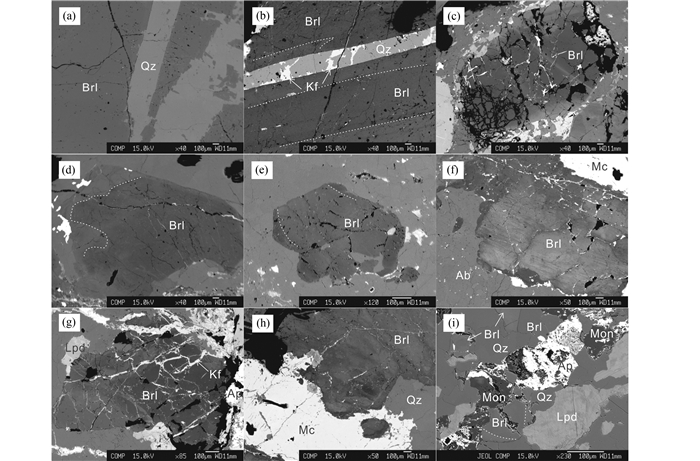
|
图 2 东秦岭稀有金属伟晶岩绿柱石的BSE图像 (a)瓦窑沟伟晶岩中均一绿柱石; (b)西山沟伟晶岩中条带状绿柱石; (c)南阳山302号脉中绿柱石的蚀变边结构; (d)大西沟伟晶岩中正蚀变边绿柱石; (e)大西沟伟晶岩中反蚀变边绿柱石; (f)南阳山703号脉蚀变边绿柱石; (g)韭菜沟伟晶岩中补丁分带和蚀变边绿柱石,发育钾长石细脉; (h)南阳山703号脉复杂不规则分带; (i)前台伟晶岩中均一绿柱石和蚀变边绿柱石. Brl-绿柱石; Mon-磷锂铝石; Lpd-锂云母; Qz-石英; Ab-钠长石; Kf-钾长石; Mc-微斜长石; Ap-磷灰石 Fig. 2 BSE images of beryl from the REL pegmatites in the East Qinling (a) homogeneous beryl from the Wayaogou pegmatite; (b) stratum beryl from the Xishan'gou pegmatite; (c) alteration rim of beryl from the Nanyangshan No. 302 pegmatite; (d) normal alteration rim of beryl from the Daxigou pegmatite; (e) reverse alteration rim of beryl from the Daxigou pegmatite; (f) alteration rim of beryl from the Nanyangshan No.703 pegmatite; (g) patch and alteration rim of beryl from the Jiucaigou pegmatite; (h) complex irregular beryl from the Nanyangshan No.703 pegmatite; (i) homogeneous and altered beryl from the Qiantai pegmatite. Brl-beryl; Mon-montebrasite; Lpd-lepidolite; Qz-quartz; Ab-albite; Kf-K-feldspar; Ap-apatite |
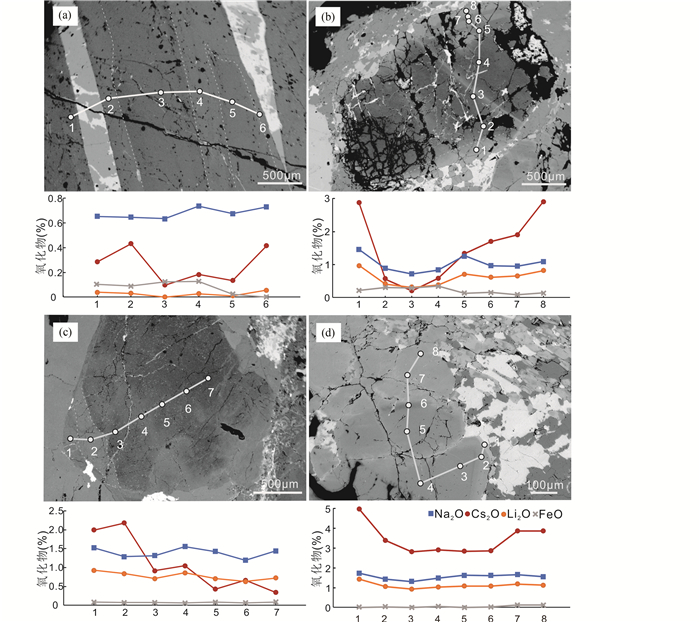
|
图 3 绿柱石内部分带化学组成变化 (a)西山沟伟晶岩中条带状绿柱石; 南阳山302号脉(b)、大西沟(c)和南阳山703号脉(d)伟晶岩中绿柱石蚀变边结构 Fig. 3 Compositional changes of internal structures of beryl (a) stratum beryl from the Xishan'gou pegmatite; alteration rims of beryl from the Nanyangshan No.302 pegmatite (b), the Daxigou pegmatite (c) and the Nanyangshan No.703 pegmatite (d) |
绿柱石-铌铁矿亚型伟晶岩产出具有均一结构、条带状分带和蚀变边结构的绿柱石。绿柱石与石英、白云母、钾长石、电气石和铌铁矿族矿物共生。瓦窑沟矿区铍矿化伟晶岩(瓦窑沟和西山沟)产出的绿柱石主要为均一结构,局部发育条带状分带(图 2a, b)。西山沟中绿柱石包裹的石英-白云母-钾长石集合体接触边相对富Cs2O(图 2a、图 3a)。南阳山302号脉铍矿化伟晶岩产出蚀变边结构绿柱石(图 2c、图 3b)。
复杂型锂辉石亚型伟晶岩中绿柱石具有正蚀变边结构(图 2d、图 3c, d)、反蚀变边结构(图 2e, f)、补丁分带(图 2g)和复杂不规则分带(图 2h)。绿柱石与石英、钠长石、钾长石、锂辉石、锂云母、磷锂铝石、磷灰石和铌铁矿族矿物等共生。蔡家沟矿区大西沟伟晶岩产出具有正/反蚀变边结构、补丁分带和复杂不规则分带的绿柱石,韭菜沟伟晶岩产出具有正蚀变边结构、补丁分带和复杂不规则分带的绿柱石。大西沟和韭菜沟锂矿化伟晶岩中绿柱石内部发育钾长石细脉(图 2g)。南阳山703号脉产出具有正/反蚀变边结构和复杂不规则分带的绿柱石。
钠长石-锂辉石型伟晶岩(前台伟晶岩)产出均一绿柱石和蚀变边结构绿柱石(图 2i)。绿柱石与石英、锂云母、磷锂铝石和磷灰石等共生。
4.2 绿柱石化学组成东秦岭卢氏地区稀有金属伟晶岩代表性绿柱石的电子探针分析结果见表 1。绿柱石的SiO2、Al2O3、BeO(计算值),Na2O、Cs2O、Li2O (计算值)含量变化范围分别是62.04%~66.53%、17.11%~18.50%、10.77%~13.64%、0.39%~2.28%、bdl:低于检出限-4.98%和0%~1.43%。绿柱石的FeO(bdl-0.39%)、SrO(bdl-0.23%)、Rb2O(0.05%~0.24%)、MgO(bdl-0.73%)和P2O5(bdl-0.16%)含量较低,TiO2、MnO、CaO、K2O和BaO多低于检出限,含量最高值分别为0.02%、0.05%、0.14%、0.26%和0.09%,F含量均低于检出限。南阳山矿区、七里沟-前台矿区和蔡家沟矿区的锂矿化伟晶岩绿柱石Cs2O含量较高(0.19%~4.98%)。瓦窑沟矿区的Be矿化伟晶岩绿柱石Cs2O含量较低(bdl-1.01%),FeO含量高(0.12%~0.39%),其中,与瓦窑沟相比,西山沟伟晶岩产出的绿柱石明显富MgO(0.55%~0.73%)。
|
|
表 1 东秦岭卢氏稀有金属伟晶岩绿柱石电子探针(EMPA)化学组成(wt%) Table 1 Chemical compositions (wt%) of beryls from the REL pegmatites in the Lushi County, East Qinling by EMPA |
绿柱石是Be-O四面体和Al-O八面体连接Si-O四面体形成的环状结构硅酸盐矿物。多种阳离子可通过替代进入绿柱石晶格。三价阳离子(Fe3+、Sc3+、Cr3+或V3+)和/或二价阳离子(Fe2+、Mg2+或Mn2+)占据八面体Al位置(Bakakin et al., 1969; Turner et al., 2007),Li占据四面体Be位置(Hawthorne and Černý,1977),由于电价平衡和离子半径较大,一价阳离子(Na+、Rb+、K+或Cs+)、二价阳离子Ca2+和H2O占据通道位置(Aines and Rossman, 1984; Novák and Filip, 2010)。绿柱石替代机制主要包括通道-八面体替代,如Na(Fe2+, Mg)□-1Al-1,Ca2(Fe2+, Mg)□-12Al-1、通道-四面体替代,如(Na, Cs)Li□-1Be-1和(Cs, Na)Al□-1Si-1、以及通道中碱金属阳离子间的置换,如CsNa-1(Aurisicchio et al., 1988; Wang et al., 2009; Novák and Filip, 2010; Uher et al., 2010)。
东秦岭卢氏地区官坡铍矿化伟晶岩中绿柱石的替代机制相对简单。西山沟绿柱石相对富Fe和富Mg,Mg与Al呈负相关,Mg与Fe呈正相关,而Na、Li、Cs含量很低,不具有相关性(图 4、表 1),替代机制为Na(Fe2+, Mg)□-1Al-1。瓦窑沟绿柱石含Fe,具有较低的Na和Li含量和极低的Cs含量,Na和Li呈线性正相关(图 5),替代机制为NaLi□-1Be-1。南阳山302号脉绿柱石Na和Li呈线性正相关,Na和Cs呈正相关(图 5),替代机制为(Na, Cs)Li□-1Be-1。铍矿化伟晶岩产出的绿柱石以通道-八面体替代或通道-四面体替代为主。锂矿化伟晶岩中绿柱石的替代机制较为复杂。南阳山703号脉边部带石英-绿色电气石带中绿柱石Na和Fe呈正相关,Fe和Al呈负相关(图 4),Na和Cs呈负相关(图 5),替代机制为NaFe2+□-1Al-1和NaCs-1,中间带锂辉石-石英-钠化微斜长石-叶钠长石-铌铁矿族矿物带中绿柱石Na和Cs呈正相关(图 5),替代机制为(Na, Cs)Li□-1Be-1。边部带Na替代Cs,表明结晶环境动荡,为晚期钠质流体交代所致。前台、大西沟和韭菜沟伟晶岩中绿柱石Na和Cs弱正相关,Na和Li呈正相关(图 5),替代机制为(Na, Cs)Li□-1Be-1。锂矿化伟晶岩产出的绿柱石替代机制包括通道-八面体替代、通道-四面体替代以及通道中碱金属阳离子间的置换。这与锂矿化伟晶岩经历高度分异演化过程,结晶介质化学组成跨度大,以及相对动荡的结晶环境,如流体交代,使得元素交换强烈等因素有关。
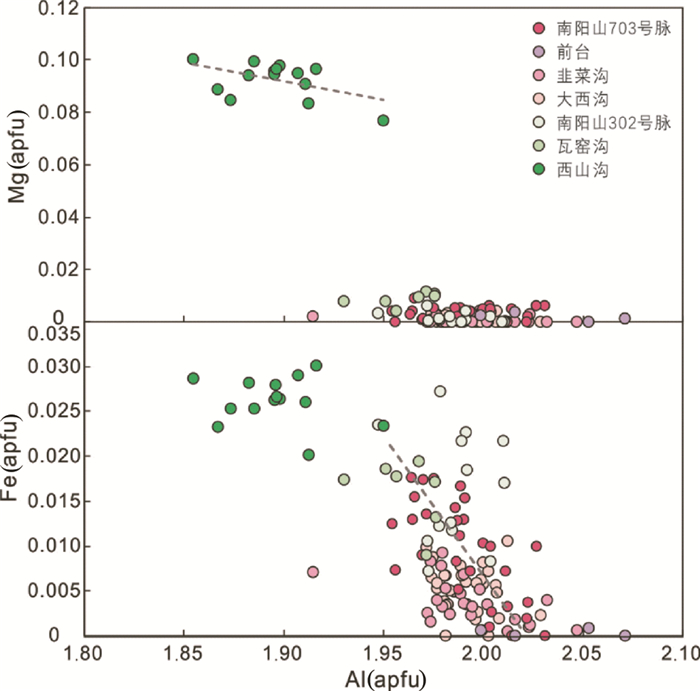
|
图 4 绿柱石Al-Mg和Al-Fe图解 Fig. 4 Plots of Al vs. Mg and Al vs. Fe |
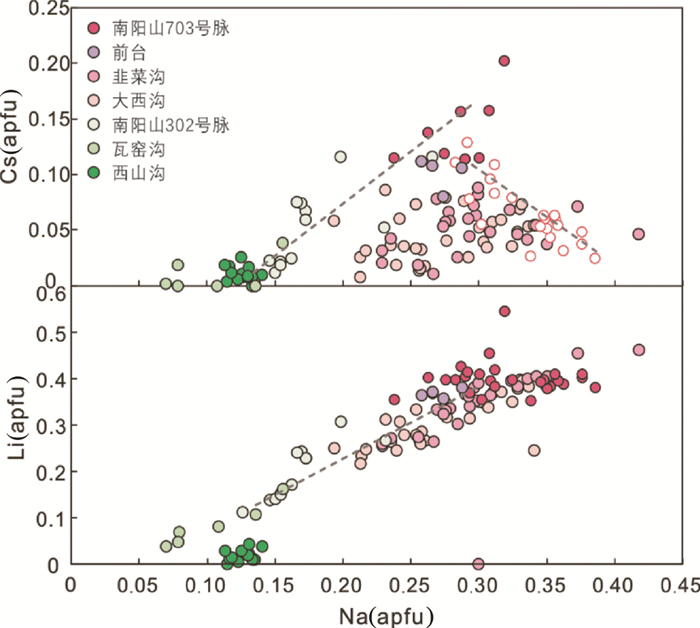
|
图 5 绿柱石Na-Cs和Na-Li图解 Fig. 5 Plots of Na vs. Cs and Na vs. Li |
花岗伟晶岩岩浆分异演化程度与稀有金属矿化密切相关(Černý,1982)。花岗伟晶岩岩浆分异程度的矿物化学指示标志包括石英的Ge/Ti值、Li、Al和Ti含量(Beurlen et al., 2011)、云母和微斜长石的K/Rb值、K/Cs值、Li、Rb、Cs和F含量(Alfonso et al., 2003;Oyarzábal et al., 2008; 周起凤等,2013)、铌铁矿族矿物的Ta/(Nb+Ta)值(Tindle and Breaks, 2000; Zhang et al., 2004)等。伟晶岩中绿柱石的碱金属元素相关性(Na/Li值、Na/Cs值和碱金属含量)以及Mg/Fe值能够反映结晶介质的地球化学和成因特征(Černý et al., 2003; Neiva and Neiva, 2005; Wang et al., 2009; Bidny et al., 2011; Zhou et al., 2015)。随花岗伟晶岩岩浆分异演化程度加大,原生绿柱石的Cs含量升高,Na/Cs值和Na/Li值降低,Mg含量降低,Mg/Fe值降低(Černý et al., 2003; Uher et al., 2010)。绿柱石的岩浆分异程度指示标志(Cs含量和Na/Cs值)对比揭示东秦岭卢氏地区稀有金属伟晶岩的分异演化程度序列,即:铍矿化伟晶岩中,瓦窑沟矿区的西山沟和瓦窑沟伟晶岩岩浆分异演化程度相近,均低于南阳山矿区铍矿化伟晶岩;锂矿化伟晶岩中,蔡家沟矿区的大西沟和韭菜沟伟晶岩岩浆分异演化程度相近,由蔡家沟矿区、七里沟-前台矿区前台伟晶岩、至南阳山703号脉锂矿化伟晶岩,伟晶岩岩浆分异演化程度增高(图 6)。锂矿化伟晶岩岩浆分异演化程度高于铍矿化伟晶岩岩浆。

|
图 6 绿柱石Na2O-Cs2O图解 Spd-锂辉石; Qz-石英; Ab-钠长石; Mc-微斜长石; Tur-电气石; Ms-白云母; Lpd-锂云母 Fig. 6 Diagram of Na2O vs. Cs2O Spd-spodumene; Qz-quartz; Ab-albite; Mc-microcline; Tur-tourmaline; Ms-muscovite; Lpd-lepidolite |
根据以上伟晶岩岩浆分异演化程度序列,随分异演化程度加大,绿柱石内部分带更为复杂,铍矿化伟晶岩产出的绿柱石以均一结构为主,偶见条带状结构和简单蚀变边结构,结晶环境相对稳定,锂矿化伟晶岩绿柱石以正/反蚀变边结构和复杂不规则分带为主,结晶介质组成变化大。这与阿尔泰可可托海3号脉不同矿化带绿柱石的内部分带特征(Wang et al., 2009; Zhou et al., 2015)相似。因此,绿柱石的内部分带特征,能够反映结晶环境和结晶介质的变化,亦可作为伟晶岩分异演化程度的潜在指示标志。另外,绿柱石FeO含量与Na/Cs值呈线性正相关,与Cs2O含量呈负相关(图 7)。可可托海3号脉与东秦岭卢氏稀有金属伟晶岩绿柱石表现出相似的变化趋势。锂矿化伟晶岩中绿柱石FeO含量低于铍矿化伟晶岩,同一伟晶岩脉内锂矿化结构带中绿柱石FeO含量低于铍矿化结构带(图 7、表 1)。即随岩浆分异演化程度加大,绿柱石FeO含量降低。这可能由于随着岩浆结晶作用的进行,体系中含铁矿物相(如铌铁矿族矿物、铁电气石和白云母等)的结晶,消耗了岩浆中的铁,使得残余岩浆FeO含量降低,后续结晶矿物表现相对低的FeO含量。因此,绿柱石FeO含量可作为岩浆分异演化程度的潜在指示标志。
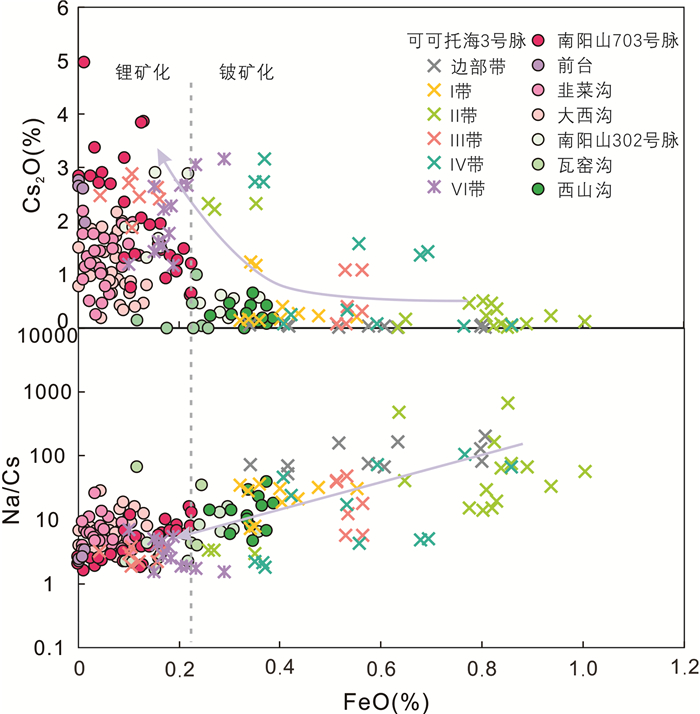
|
图 7 绿柱石FeO-Cs2O和FeO-Na/Cs图解 可可托海3号脉绿柱石数据来自Zhou et al., 2015 Fig. 7 Plots of FeO vs. Cs2O and FeO vs. Na/Cs The contents of FeO and Cs2O and Na/Cs values of beryl from the Koktokay No.3 pegmatite are from Zhou et al. (2015) |
蔡家沟矿区中大西沟和韭菜沟伟晶岩中不同结构带产出的绿柱石Cs含量相近,表明伟晶岩岩浆就位后未经历明显分异演化过程(图 6)。蔡家沟矿区锂矿化伟晶岩岩浆在就位时即是富集稀有金属的矿化伟晶岩岩浆,具有较高的分异演化程度。尽管蔡家沟矿区锂矿化伟晶岩发育微斜长石-石英带,化学组成上不同于钠长石-锂辉石型伟晶岩,但伟晶岩脉内部结构分带简单,且岩浆就位后未经历明显分异演化过程的情况与钠长石-锂辉石型伟晶岩(如阿尔泰造山带柯鲁木特和库卡拉盖锂矿, 王春龙, 2017;川西甲基卡新三号脉锂矿, 付小方等, 2015)相近。另外,蔡家沟矿区中大西沟和韭菜沟伟晶岩中绿柱石均发育钾长石细脉(图 2f),可能为晚期钾质流体/熔体作用的产物,该晚期钾质流体/熔体是否进一步富集稀有金属元素尚不清楚。七里沟-前台矿区的前台伟晶岩脉锂矿化结构带中绿柱石Cs含量高于蔡家沟矿区,低于南阳山703号脉中间带,且伟晶岩内部结构分带简单,属钠长石-锂辉石型,推测岩浆就位后可能也未经历明显分异演化过程,岩浆就位时即高度分异演化的稀有金属伟晶岩岩浆。南阳山703号脉边部带绿柱石与蔡家沟矿区锂矿化结构带绿柱石具有相近的Cs含量,表明南阳山703号脉岩浆就位时为高度分异演化的稀有金属伟晶岩岩浆。南阳山703号脉中间带(锂辉石-石英-钠化微斜长石-叶钠长石-铌铁矿族矿物带)原生绿柱石Cs含量明显高于边部带(石英-绿色电气石带)绿柱石(图 6),表明由外向内,伟晶岩岩浆分异演化程度升高,结晶介质更为富Cs贫Fe,岩浆就位后经历结晶分异作用,完成进一步的稀有金属富集过程。这与多数具有复杂对称分带的高度分异演化伟晶岩(如可可托海3号脉, Zhou et al., 2015;加拿大Tanco矿床, Van Lichtervelde et al., 2007)的演化过程相似。南阳山703号脉是高度分异演化的稀有金属伟晶岩岩浆就位后通过分异演化进一步富集而成。
由上,官坡锂矿化伟晶岩具有较高的分异演化程度,且伟晶岩岩浆在就位时即是高度分异演化的稀有金属伟晶岩岩浆。锂矿化伟晶岩岩浆的成因包括:(1)连续或断续的熔体抽离致使残余岩浆富集挥发分和锂等稀有金属(Trueman and Černý,1982; Černý, 1991b); (2)高度分异演化的具有垂向化学分带的母体岩浆岩的继承(Simmons et al., 1987; Poli and Tommasini, 1991; London, 1990, 1992; Bea et al., 1994; Mahood et al., 1996); (3)富集稀有金属元素的沉积岩通过阶段性脱水反应逐步释放至深熔熔体中,通过结晶分异作用不断富集(Breaks and Moore, 1992)。东秦岭官坡地区产出多个花岗质岩体(灰池子、桃坪、漂池等),官坡锂矿化稀有金属伟晶岩岩浆的成因有待进一步研究和探讨,但结晶分异作用在锂矿化伟晶岩岩浆的形成中起了至关重要的作用。另外,稀有金属伟晶岩岩浆是极度富水、挥发分和稀有金属的过铝质硅酸盐岩浆(Černý,1991a,b; Webster et al., 1997; London,2005; Thomas and Davidson, 2012,2016)。与瓦窑沟矿区铍矿化伟晶岩相比,官坡密集区锂矿化伟晶岩产出的绿柱石内部分带更为复杂(图 2、图 3),反映不平衡的结晶环境和熔体的不均一性,表明体系中广泛发生液相不混溶和交代作用。因此,与铍矿化伟晶岩岩浆相比,锂矿化伟晶岩岩浆更为富水、挥发分和稀有金属(尤其是锂),更容易发生液相不混溶和交代作用,且携带稀有金属的能力更强(王联魁等,2002; Veksler,2004; Badanina et al., 2006; 李建康等,2006)。液相不混溶是锂矿化伟晶岩岩浆就位后的稀有金属富集机制之一。通过锂矿化伟晶岩岩浆成因与成矿过程探讨,认为结晶分异和液相不混溶是官坡锂矿化伟晶岩的稀有金属成矿机制。
6 结论(1) 东秦岭北部官坡稀有金属伟晶岩中绿柱石元素替代机制包括通道-八面体替代、通道-四面体替代以及通道中碱金属阳离子间的置换。铍矿化伟晶岩中,西山沟、瓦窑沟和南阳山302号脉的替代机制分别为Na(Fe2+, Mg)□-1Al-1、NaLi□-1Be-1和(Na, Cs)Li□-1Be-1。锂矿化伟晶岩中,南阳山703号脉的替代机制包括NaFe2+□-1Al-1、NaCs-1和(Na, Cs)Li□-1Be-1,前台、大西沟和韭菜沟的替代机制为(Na, Cs)Li□-1Be-1。
(2) 铍矿化伟晶岩岩浆分异演化程度低于锂矿化伟晶岩岩浆。铍矿化伟晶岩中,瓦窑沟矿区低于南阳山矿区。锂矿化伟晶岩中,由蔡家沟矿区锂矿化伟晶岩、七里沟-前台矿区前台伟晶岩、至南阳山703号脉锂矿化伟晶岩,伟晶岩岩浆分异演化程度依次增高。
(3) 绿柱石FeO含量和内部分带特征可作为花岗伟晶岩分异演化程度的潜在指示标志。随伟晶岩岩浆分异演化程度升高,绿柱石FeO含量降低,内部分带更为复杂,发育复杂蚀变边结构和不规则分带等。
(4) 东秦岭官坡锂矿化伟晶岩岩浆就位时是高度分异演化的稀有金属伟晶岩岩浆。蔡家沟矿区锂矿化伟晶岩和七里沟-前台矿区前台伟晶岩岩浆就位后未经历明显分异演化过程,而南阳山703号脉伟晶岩岩浆就位后经历了分异演化过程。稀有金属成矿机制是结晶分异和液相不混溶。
致谢 卢氏伟晶岩研究从与朱日祥院士、吴福元院士、叶大年院士的讨论中受益良多;河南省卢氏县国土资源局和卢氏中科矿业有限公司有关领导和同仁在野外工作中提供了大力协助和支持;中国科学院地质与地球物理研究所贾丽辉和张迪工程师在电子探针分析测试时给予了帮助;审稿专家李建康研究员和车旭东副教授提出了宝贵的意见和建议。在此一并表示衷心的感谢。
谨以此文敬贺叶大年先生八十华诞!
Aines RD and Rossman GR. 1984. The high temperature behavior of water and carbon dioxide in cordierite and beryl. American Mineralogist, 60(3-4): 319-327 |
Alfonso P, Melgarejo JC, Yusta I and Velasco F. 2003. Geochemistry of feldspars and muscovite in granitic pegmatite from the Cap De Creus field, Catalonia, Spain. The Canadian Mineralogist, 41(1): 103-116 DOI:10.2113/gscanmin.41.1.103 |
Armstrong JT. 1989. CITZAF:Combined ZAF and Phi-rho (Z) electron beam correction programs. Pasadena, California: California Institute of Technology
|
Aurisicchio C, Fioravanti G, Grubessi O and Zanazzi PF. 1988. Reappraisal of the crystal chemistry of beryl. American Mineralogist, 73(7-8): 826-837 |
Badanina EV, Trumbull RB, Dulski P, Wiedenbeck M, Veksler IV and Syritso LF. 2006. The behavior of rare-earth and lithophile trace elements in rare-metal granites:A study of fluorite, melt inclusions and host rocks from the Khangilay complex, Transbaikalia, Russia. The Canadian Mineralogist, 44(3): 667-692 DOI:10.2113/gscanmin.44.3.667 |
Bai F, Feng HY, Zou SJ and Liu J. 2011. A mineralogical study of spodumene from Guanpo pegmatites in Lushi, Henan Province. Acta Petrologica et Mineralogica, 30(2): 281-285 (in Chinese with English abstract) |
Bakakin VV, Rylov GM and Belov NV. 1969. Crystal structure of lithium-bearing beryl. Akad. Nauk. SSSR Doklady, 188: 659-662 |
Bea F, Pereira MD, Corretgé LG and Fershtater GB. 1994. Differentiation of strongly peraluminous, perphosphorus granites:The Pedrobernardo pluton, central Spain. Geochimica et Cosmochimica Acta, 58(12): 2609-2627 DOI:10.1016/0016-7037(94)90132-5 |
Beurlen H, Müller A, Silva D and da Silva MRR. 2011. Petrogenetic significance of LA-ICP-MS trace-element data on quartz from the Borborema pegmatite province, Northeast Brazil. Mineralogical Magazine, 75(5): 2703-2719 DOI:10.1180/minmag.2011.075.5.2703 |
Bidny AS, Baksheev IA, Popov MP and Anosova MO. 2011. Beryl from deposits of the Ural emerald belt, Russia:ICP-MS-LA and infrared spectroscopy study. Moscow University Geology Bulletin, 66(2): 108-115 DOI:10.3103/S0145875211020037 |
Brand AA, Groat LA, Linnen RL, Garland MI, Breaks FW and Giuliani G. 2009. Emerald mineralization associated with the Mavis Lake pegmatite group, near Dryden, Ontario. The Canadian Mineralogist, 47(2): 315-336 DOI:10.3749/canmin.47.2.315 |
Breaks FW and Moore JM. 1992. The Ghost Lake batholith, Superior Province of northwestern Ontario:A fertile, S-Type, peraluminous granite-rare-element pegmatite system. The Canadian Mineralogist, 30(3): 835-875 |
Černý P. 1982. Petrogenesis of granitic pegmatites. In: Černý P (ed.). Granitic Pegmatites in Science and Industry. Winnipeg, Canada: Mineralogical Association of Canada, 8: 405-462
|
Černý P. 1991a. Rare-element granitic pegmatites. Part Ⅰ:Anatomy and internal evolution of pegmatitic deposits. Geoscience Canada, 18(2): 49-67 |
Černý P. 1991b. Rare-element granitic pegmatites. Part Ⅱ:Regional to global environments and petrogenesis. Geoscience Canada, 18(2): 68-81 |
Černý P, Ander son AJ, Tomascak PB and Chapman R. 2003. Geochemical and morphological features of beryl from the Bikita granitic pegmatite, Zimbabwe. The Canadian Mineralogist, 41(4): 1003-1011 DOI:10.2113/gscanmin.41.4.1003 |
Černý P and Ercit TS. 2005. The classification of granitic pegmatites revisited. The Canadian Mineralogist, 43(6): 2005-2026 DOI:10.2113/gscanmin.43.6.2005 |
Chen XJ. 1982. The distribution of granitic pegmatites in the East Qinling. Journal of Changan University (Geoscience Edition), (1): 10-16, 9 (in Chinese) |
Chen ZH, Lu SN, Li HK, Li HM, Xiang ZQ, Zhou HY and Song B. 2006. Constraining the role of the Qinling orogen in the assembly and break-up of Rodinia:Tectonic implications for Neoproterozoic granite occurrences. Journal of Asian Earth Sciences, 28(1): 99-115 DOI:10.1016/j.jseaes.2005.03.011 |
Cheng H, Zhang C, Vervoort JD, Li XH, Li QL, Zheng S and Gao DD. 2011. Geochronology of the transition of eclogite to amphibolite facies metamorphism in the North Qinling orogen of central China. Lithos, 125(3-4): 969-983 DOI:10.1016/j.lithos.2011.05.010 |
Cheng H, Zhang C, Vervoort JD, Li XH, Li QL, Wu YB and Zheng S. 2012. Timing of eclogite facies metamorphism in the North Qinling by U-Pb and Lu-Hf geochronology. Lithos, 136-139: 46-59 DOI:10.1016/j.lithos.2011.06.003 |
Feng MY, Rong JS, Sun ZF, Xu ZY, Xie HJ and Liu QF. 1997. The formation mechanism and prognosis on the prospect of pegmatite type uranium deposit in Eastern Qinling of China. China Nuclear Science and Technology Report, (Suppl.): 1-10 (in Chinese with English abstract) |
Fridrichová J, Bačík P, Rusinová P, Antal P, Škoda R, Bizovská V and Miglierini M. 2015. Optical and crystal-chemical changes in aquamarines and yellow beryls from Thanh Hoa Province, Vietnam induced by heat treatment. Physics and Chemistry of Minerals, 42(4): 287-302 DOI:10.1007/s00269-014-0719-4 |
Fu XF, Yuan LP, Wang DH, Hou LW, Pan M, Hao XF, Liang B and Tang Y. 2015. Mineralization characteristics and prospecting model of newly discovered X03 rare metal vein in Jiajika orefield, Sichuan. Mineral Deposits, 34(6): 1172-1186 (in Chinese with English abstract) |
Groat LA, Rossman GR, Dyar MD, Turner DJ, Piccoli PMB, Schultz AJ and Ottolini L. 2010. Crystal chemistry of dark blue aquamarine from the True Blue showing, Yukon Territory, Canada. The Canadian Mineralogist, 48(3): 597-613 DOI:10.3749/canmin.48.3.597 |
Grundmann G and Morteani G. 2008. Multi-stage emerald formation during Pan-African regional metamorphism:The Zabara, Sikait, Umm Kabo deposits, South Eastern desert of Egypt. Journal of African Earth Sciences, 50(2-4): 168-187 DOI:10.1016/j.jafrearsci.2007.09.009 |
Hawthorne FC and Černý P. 1977. The alkali-metal positions in Cs-Li beryl. The Canadian Mineralogist, 15(3): 414-421 |
Hawthorne FC, Cooper MA, Simmons WB, Falster AU, Laurs BM, Armbruster T, Rossman GR, Peretti A, Günter D and Grobety B. 2004. Pezzottaite, Cs(Be2Li)Al2Si6O18:A spectacular new mineral related to the Beryl group, from Madagascar. Mineralogical Record, 35(5): 369-378 |
He RL and Cao EK. 1985. The characteristics of stibiobismutoantalite within granite pegmatite in Guanpo area, Henan Province. Geology of Shannxi, 3(2): 39-46 (in Chinese with English abstract) |
He YL and Huang CY. 2012. A preliminary metallogenic study of rare-metal pegmatites in Lushi, Henan Province. Science & Technology Information, (28): 77-78 (in Chinese) |
Lei M. 2010. Petrogenesis of granites and their relation to tectonic evolution of orogen in the east part of Qinling orogenic belt. Ph. D. Dissertation. Beijing: Chinese Academy of Geological Sciences, 1-162 (in Chinese with English abstract)
|
Li JK, Wang DH, Zhang DH and Fu XF. 2006. The discovery of silicate daughter mineral-bearing inclusions in the Jiajika pegmatite deposit, western Sichuan, and its significance. Mineral Deposits, 25(Suppl.): 131-134 (in Chinese) |
Liu YX. 1984. The geochemical characteristics of the Be-mineralization in the granitic pegmatite of the eastern Qinling mountains. Journal of Mineralogy and Petrology, (3): 109-118 (in Chinese with English abstract) |
London D. 1990. Internal differentiation of rare-element pegmatites: A synthesis of recent research. In: Stein HJ and Hannah JL (eds.). Ore-Bearing Granite Systems: Petrogenesis and Mineralizing Processes. Geological Society of America, 246: 35-50
|
London D. 1992. The application of experimental petrology to the genesis and crystallization of granitic pegmatites. The Canadian Mineralogist, 30(3): 499-540 |
London D. 2005. Granitic pegmatites:An assessment of current concepts and directions for the future. Lithos, 80(1-4): 281-303 DOI:10.1016/j.lithos.2004.02.009 |
Lu XX. 2000. Tectonic Map of Granite in Eastern Qinling Belt (with Notes). Xi'an: Xi'an Map Publishing House (in Chinese)
|
Lu XX, Zhu CH, Gu DM, Zhang HM, Wu M and Wu Y. 2010. The main geological and metallogenic characteristics of granitic pegmatite in Eastern Qinling Belt. Geological Review, 56(1): 21-30 (in Chinese with English abstract) |
Luan SW. 1979. Some geochemical features of a rare element-bearing granite-pegmatite in the eastern Qinling Range. Geochimica, (4): 322-330 (in Chinese with English abstract) |
Luan SW. 1985. Mineralogy, geochemistry and economic geology of rare elements granite in the eastern Qinling Orogen. Abstracts of Papers of National Pegmatite Academic Symposium: 1-3 (in Chinese) |
Lum JE, Viljoen F, Cairncross B and Frei D. 2016. Mineralogical and geochemical characteristics of beryl (aquamarine) from the Erongo Volcanic Complex, Namibia. Journal of African Earth Sciences, 124: 104-125 DOI:10.1016/j.jafrearsci.2016.09.006 |
Mahood GA, Nibler GE and Halliday AN. 1996. Zoning patterns and petrologic processes in peraluminous magma chambers:Hall Canyon pluton, Panamint Mountains, California. GSA Bulletin, 108(4): 437-453 DOI:10.1130/0016-7606(1996)108<0437:ZPAPPI>2.3.CO;2 |
Meng QR and Zhang GW. 2000. Geologic framework and tectonic evolution of the Qinling orogen, central China. Tectonophysics, 323(3-4): 183-196 DOI:10.1016/S0040-1951(00)00106-2 |
Merino E, Villaseca C, Orejana D and Jeffries T. 2013. Gahnite, chrysoberyl and beryl co-occurrence as accessory minerals in a highly evolved peraluminous pluton:The Belvís de Monroy leucogranite (Cáceres, Spain). Lithos, 179: 137-156 DOI:10.1016/j.lithos.2013.08.004 |
Michallik RM, Wagner T, Fusswinkel T, Heinonen JS and Heikkilä P. 2017. Chemical evolution and origin of the Luumäki gem beryl pegmatite:Constraints from mineral trace element chemistry and fractionation modeling. Lithos, 274-275: 147-168 DOI:10.1016/j.lithos.2017.01.001 |
Mihalynuk MG and Lett R. 2003. Composition of Logtung beryl (aquamarine) by ICPES/MS: A comparison with beryl worldwide. In: Geological Fieldwork 2003. British Columbia: Crown Publications Inc., 141-146
|
Neiva AMR and Neiva JMC. 2005. Beryl from the granitic pegmatite at Namivo, Alto Ligonha, Mozambique. Neues Jahrbuch für Mineralogie-Abhandlungen, 181(2): 173-182 https://www.researchgate.net/publication/233598179_Beryl_from_the_granitic_pegmatite_at_Namivo_Alto_Ligonha_Mozambique
|
Novák M and Filip J. 2010. Unusual (Na, Mg)-enriched beryl and its breakdown products (beryl Ⅱ, bazzite, bavenite) from euxenite-type NYF pegmatite related to the orogenic ultrapotassic Třebíč pluton, Czech Republic. The Canadian Mineralogist, 48(3): 615-628 DOI:10.3749/canmin.48.3.615 |
Oyarzábal J, Galliski Má and Perino E. 2009. Geochemistry of K-feldspar and Muscovite in rare-element pegmatites and granites from the Totoral pegmatite field, San Luis, Argentina. Resource Geology, 59(4): 315-329 DOI:10.1111/rge.2009.59.issue-4 |
Poli G and Tommasini S. 1991. A geochemical approach to the evolution of granitic plutons:A case study, the acid intrusions of Punta Falcone (northern Sardinia, Italy). Chemical Geology, 92(1-3): 87-105 DOI:10.1016/0009-2541(91)90050-2 |
Qin KZ, Zhai MG, Li GM, Zhao JX, Zeng QD, Gao J, Xiao WJ, Li JL and Sun S. 2017. Links of Collage orogenesis of multiblocks and crust evolution to characteristic metallogeneses in China. Acta Petrologica Sinica, 33(2): 305-325 (in Chinese with English abstract) |
Qin ZW, Wu YB, Wang H, Gao S, Zhu LQ, Zhou LA and Yang SH. 2014. Geochronology, geochemistry, and isotope compositions of Piaochi S-type granitic intrusion in the Qinling orogen, central China:Petrogenesis and tectonic significance. Lithos, 202-203: 347-362 DOI:10.1016/j.lithos.2014.06.006 |
Qin ZW, Wu YB, Siebel W, Gao S, Wang H, Abdallsamed MIM, Zhang WX and Yang SH. 2015. Genesis of adakitic granitoids by partial melting of thickened lower crust and its implications for early crustal growth:A case study from the Huichizi pluton, Qinling orogen, central China. Lithos, 238: 1-12 DOI:10.1016/j.lithos.2015.09.017 |
Ratschbacher L, Hacker BR, Calvert A, Webb LE, Grimmer JC, McWilliams MO, Ireland T, Dong SW and Hu JM. 2003. Tectonics of the Qinling (Central China):Tectonostratigraphy, geochronology, and deformation history. Tectonophysics, 366(1-2): 1-53 DOI:10.1016/S0040-1951(03)00053-2 |
Shi Y, Yu JH, Xu XS, Qiu JS and Chen LH. 2009. Geochronology and geochemistry of the Qinling Group in the eastern Qinling Orogen. Acta Petrologica Sinica, 25(10): 2651-2670 (in Chinese with English abstract) |
Simmons WB, Lee MT and Brewster RH. 1987. Geochemistry and evolution of the South Platte granite-pegmatite system, Jefferson County, Colorado. Geochimica et Cosmochimica Acta, 51(3): 455-471 DOI:10.1016/0016-7037(87)90061-5 |
Thomas R and Davidson P. 2012. Water in granite and pegmatite-forming melts. Ore Geology Reviews, 46: 32-46 DOI:10.1016/j.oregeorev.2012.02.006 |
Thomas R and Davidson P. 2016. Revisiting complete miscibility between silicate melts and hydrous fluids, and the extreme enrichment of some elements in the supercritical state:Consequences for the formation of pegmatites and ore deposits. Ore Geology Reviews, 72: 1088-1101 DOI:10.1016/j.oregeorev.2015.10.004 |
Tindle AG and Breaks FW. 2000. Columbite-tantalite mineral chemistry from rare-element granitic pegmatites:Separation Lakeh area, N.W. Ontario, Canada. Mineralogy and Petrology, 70(3-4): 165-198 DOI:10.1007/s007100070002 |
Trueman DL and Černý P. 1982. Exploration for rare-element granitic pegmatites. In: Cěrny P (ed.). Granitic Pegmatites in Science and Industry. Winnipeg, Canada: Mineralogical Association of Canada, 8: 463-494
|
Turner D, Groat LA, Hart CJR, Mortensen JK, Linnen RL, Giuliani G and Wengzynowski W. 2007. Mineralogical and geochemical study of the True Blue aquamarine showing, southern Yukon. The Canadian Mineralogist, 45(2): 203-227 DOI:10.2113/gscanmin.45.2.203 |
Uher P, Chudík P, Bačík P, Vaculovič T and Galiová M. 2010. Beryl composition and evolution trends:An example from granitic pegmatites of the beryl-columbite subtype, Western Carpathians, Slovakia. Journal of Geosciences, 55(1): 69-80 |
Van Lichtervelde M, Salvi S, Beziat D and Linnen RL. 2007. Textural features and chemical evolution in tantalum oxides:Magmatic versus hydrothermal origins for Ta mineralization in the Tanco Lower Pegmatite, Manitoba, Canada. Economic Geology, 102(2): 257-276 DOI:10.2113/gsecongeo.102.2.257 |
Veksler IV. 2004. Liquid immiscibility and its role at the magmatic-hydrothermal transition:A summary of experimental studies. Chemical Geology, 210(1-4): 7-31 DOI:10.1016/j.chemgeo.2004.06.002 |
Viana RR, Da Costa GM, De Grave E, Jordt-Evangelista H and Stern WB. 2002. Characterization of beryl (aquamarine variety) by Mössbauer spectroscopy. Physics and Chemistry of Minerals, 29(1): 78-86 |
Wang CL. 2017. Li-Be-Nb-Ta mineralization in the Kelumute-Jideke ore deposit cluster, Chinese Altai. Ph. D. Dissertation. Urumqi: Xinjiang Institute of Ecology and Geography, Chinese Academy of Sciences, 1-238 (in Chinese)
|
Wang H, Wu YB, Li CR, Zhao TY, Qin ZW, Zhu LQ, Gao S, Zheng JP, Liu XM, Zhou L, Zhang Y and Yang SH. 2014. Recycling of sediment into the mantle source of K-rich mafic rocks:Sr-Nd-Hf-O isotopic evidence from the Fushui complex in the Qinling orogen. Contributions to Mineralogy and Petrology, 168(4): 1062 DOI:10.1007/s00410-014-1062-y |
Wang LK, Wang HF and Huang ZL. 2002. Geochemical indicators of isotopes in Li-F granit liquid segregation. Geology and Prospecting, 38(5): 38-43 (in Chinese with English abstract) |
Wang LQ, Guo R, Wang JQ, Fu Y and Fu ZG. 2011. The East Qinling rare metal deposit ore-form and distribution characteristics:Taking several deposits in Henan Lushi and Nanzhao areas as example. China Molybdenum Industry, 35(4): 18-21 (in Chinese with English abstract) |
Wang RC, Che XD, Zhang WL, Zhang AC and Zhang H. 2009. Geochemical evolution and late re-equilibration of Na-Cs-rich beryl from the Koktokay #3 pegmatite (Altai, NW China). European Journal of Mineralogy, 21(4): 795-809 DOI:10.1127/0935-1221/2009/0021-1936 |
Wang T, Wang XX, Tian W, Zhang CL, Li WP and Li S. 2009. North Qinling Paleozoic granite associations and their variation in space and time:Implications for orogenic processes in the orogens of central China. Science in China (Series D), 52(9): 1359-1384 DOI:10.1007/s11430-009-0129-5 |
Wang XX, Wang T and Zhang CL. 2015. Granitoid magmatism in the Qinling orogen, central China and its bearing on orogenic evolution. Science China (Earth Sciences), 58(9): 1497-1512 DOI:10.1007/s11430-015-5150-2 |
Webster JD, Thomas R, Rhede D, Förster HJ and Seltmann R. 1997. Melt inclusions in quartz from an evolved peraluminous pegmatite:Geochemical evidence for strong tin enrichment in fluorine-rich and phosphorus-rich residual liquids. Geochimica et Cosmochimica Acta, 61(13): 2589-2604 DOI:10.1016/S0016-7037(97)00123-3 |
Wu YB and Zheng YF. 2013. Tectonic evolution of a composite collision orogen:An overview on the Qinling-Tongbai-Hong'an-Dabie-Sulu orogenic belt in central China. Gondwana Research, 23(4): 1402-1428 DOI:10.1016/j.gr.2012.09.007 |
Zhang AC, Wang RC, Hu H, Zhang H, Zhu JC and Chen XM. 2004. Chemical evolution of Nb-Ta oxides and zircon from the Koktokay No. 3 granitic pegmatite, Altai, northwestern China. Mineralogical Magazine, 68(5): 739-756 |
Zhang CL, Liu L, Wang T, Wang XX, Li L, Gong QF and Li XF. 2013. Granitic magmatism related to Early Paleozoic continental collision in North Qinling. Chinese Science Bulletin, 58(35): 4405-4410 DOI:10.1007/s11434-013-6064-z |
Zhang HF, Luo TC and Zhang BR. 1996. The source and tectonic setting of the Piaochi batholith in the North Qinling. Geological Review, 42(3): 209-214 (in Chinese with English abstract) |
Zhang HF, Yu H, Zhou DW, Zhang J, Dong YP and Zhang GW. 2015. The meta-gabbroic complex of Fushui in North Qinling orogen:A case of syn-subduction mafic magmatism. Gondwana Research, 28(1): 262-275 DOI:10.1016/j.gr.2014.04.010 |
Zhang JX, Yu SY and Meng FC. 2011. Ployphase Early Paleozoic metamorphism in the northern Qinling orogenic belt. Acta Petrologica Sinica, 27(4): 1179-1190 (in Chinese with English abstract) |
Zhang ZL. 1983. The discovery of manganosicklerite in Qinling granitic pegmatites, Qinling Mountains, North China. Journal of Chengdu College of Geology, (1): 52-56 (in Chinese with English abstract) |
Zhang ZL. 1984. The discovery of a six-layered Cs-rich lepidolite in Qinling Mountain pegmatites. Journal of Chengdu College of Geology, (1): 31-36 (in Chinese with English abstract) |
Zhou QF, Qin KZ, Tang DM, Ding JG and Guo ZL. 2013. Mineralogy and significance of micas and feldspars from the Koktokay No. 3 pegmatitic rare-element deposit, Altai. Acta Petrologica Sinica, 29(9): 3004-3022 (in Chinese with English abstract) |
Zhou QF, Qin KZ, Tang DM, Wang CL, Tian Y and Sakyi PA. 2015. Mineralogy of the Koktokay No. 3 pegmatite, Altai, NW China:Implications for evolution and melt-fluid processes of rare-metal pegmatites. European Journal of Mineralogy, 27(3): 433-457 |
Zhou QF, Qin KZ, Tang DM, Wang CL and Sakyi PA. 2018. LA-ICP-MS U-Pb zircon, columbite-tantalite and 40Ar-39Ar muscovite age constraints for the rare-element pegmatite dykes in the Altai orogenic belt, NW China. Geological Magazine, 155(3): 707-728 DOI:10.1017/S0016756816001096 |
白峰, 冯恒毅, 邹思劼, 刘姣. 2011. 河南卢氏官坡伟晶岩中锂辉石的矿物学特征研究. 岩石矿物学杂志, 30(2): 281-285. DOI:10.3969/j.issn.1000-6524.2011.02.012 |
陈西京. 1982. 论东秦岭某地花岗伟晶岩的分布规律. 长安大学学报(地球科学版), (1): 10-16, 9. |
冯明月, 戎嘉树, 孙志富, 徐梓阳, 谢红接, 刘启峰. 1997. 东秦岭伟晶岩型铀矿形成机理及远景预测. 中国核科技报告, (增): 1-10. |
付小方, 袁蔺平, 王登红, 侯立玮, 潘蒙, 郝雪峰, 梁斌, 唐屹. 2015. 四川甲基卡矿田新三号稀有金属矿脉的成矿特征与勘查模型. 矿床地质, 34(6): 1172-1186. |
何瑞林, 曹恩魁. 1985. 河南官坡花岗伟晶岩中铋钽锑矿的特征. 陕西地质, 3(2): 39-46. |
何玉良, 黄岑杨. 2012. 河南省卢氏地区伟晶岩型稀有金属矿成矿规律初步研究. 科技资讯, (28): 77-78. DOI:10.3969/j.issn.1672-3791.2012.28.061 |
雷敏. 2010.秦岭造山带东部花岗岩成因及其与造山带构造演化的关系.博士学位论文.北京: 中国地质科学院, 1-162 http://cdmd.cnki.com.cn/Article/CDMD-82501-2011012326.htm
|
李建康, 王登红, 张德会, 付小方. 2006. 川西甲基卡伟晶岩型矿床中含硅酸盐子矿物包裹体的发现及其意义. 矿床地质, 25(增): 131-134. |
刘永先. 1984. 秦岭东段花岗伟晶岩中铍矿化的地球化学特征. 矿物岩石, (3): 109-118. |
卢欣祥. 2000. 东秦岭花岗岩大地构造图(附说明). 西安: 西安地图出版社.
|
卢欣祥, 祝朝辉, 古德敏, 张画眠, 吴梅, 吴艳. 2010. 东秦岭花岗伟晶岩的基本地质矿化特征. 地质论评, 56(1): 21-30. |
栾世伟. 1979. 秦东稀有元素花岗伟晶岩某些地球化学特征. 地球化学, (4): 322-330. DOI:10.3321/j.issn:0379-1726.1979.04.005 |
栾世伟. 1985.东秦岭东段稀有元素花岗岩矿物学、地球化学及矿床学.见: 全国伟晶岩学术交流会论文摘要汇编, 1-3
|
秦克章, 翟明国, 李光明, 赵俊兴, 曾庆栋, 高俊, 肖文交, 李继亮, 孙枢. 2017. 中国陆壳演化、多块体拼合造山与特色成矿的关系. 岩石学报, 33(2): 305-325. |
时毓, 于津海, 徐夕生, 邱检生, 陈立辉. 2009. 秦岭造山带东段秦岭岩群的年代学和地球化学研究. 岩石学报, 25(10): 2651-2670. |
王春龙. 2017.阿尔泰柯鲁木特-吉得克矿集区Li-Be-Nb-Ta成矿作用.博士学位论文.乌鲁木齐: 中国科学院新疆生态与地理研究所, 1-238 http://d.old.wanfangdata.com.cn/Thesis/Y3254898
|
王联魁, 王慧芬, 黄智龙. 2002. Li-F花岗岩液态分离的同位素地球化学标志. 地质与勘探, 38(5): 38-43. DOI:10.3969/j.issn.0495-5331.2002.05.008 |
王令全, 郭锐, 王军强, 付阳, 付治国. 2011. 东秦岭稀有金属矿床成矿与分布特征——以河南省卢氏、南召两地区几个矿床为例. 中国钼业, 35(4): 18-21. DOI:10.3969/j.issn.1006-2602.2011.04.004 |
王涛, 王晓霞, 田伟, 张成立, 李伍平, 李舢. 2009. 北秦岭古生代花岗岩组合、岩浆时空演变及其对造山作用的启示. 中国科学(D辑), 39(7): 949-971. |
王晓霞, 王涛, 张成立. 2015. 秦岭造山带花岗质岩浆作用与造山带演化. 中国科学(地球科学), 45(8): 1109-1125. |
张成立, 刘良, 王涛, 王晓霞, 李雷, 龚齐福, 李小菲. 2013. 北秦岭早古生代大陆碰撞过程中的花岗岩浆作用. 科学通报, 58(23): 2323-2329. |
张宏飞, 骆庭川, 张本仁. 1996. 北秦岭漂池岩体的源区特征及其形成的构造环境. 地质论评, 42(3): 209-214. DOI:10.3321/j.issn:0371-5736.1996.03.003 |
张建新, 于胜尧, 孟繁聪. 2011. 北秦岭造山带的早古生代多期变质作用. 岩石学报, 27(4): 1179-1190. |
张志兰. 1983. 秦岭花岗伟晶岩中的锰褐磷锂矿. 成都地质学院学报, (1): 52-56. |
张志兰. 1984. 秦岭东段伟晶岩中银白色富铯锂云母. 成都地质学院学报, (1): 31-36. |
周起凤, 秦克章, 唐冬梅, 丁建刚, 郭正林. 2013. 阿尔泰可可托海3号脉伟晶岩型稀有金属矿床云母和长石的矿物学研究及意义. 岩石学报, 29(9): 3004-3022. |
 2019, Vol. 35
2019, Vol. 35

